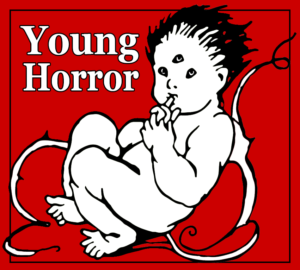YA Writing Prompt: Cabin Fever
 Young Horror brings you writing prompts to energize your week with spooky writing idea inspiration. Are you writing picture books, chapter books, middle grade, or YA? Your next great idea could be sparked right here.
Young Horror brings you writing prompts to energize your week with spooky writing idea inspiration. Are you writing picture books, chapter books, middle grade, or YA? Your next great idea could be sparked right here.
The Horrors of Winter Break
Ah…take a breath, because December brings with it Winter Break. There’s a short vacation for kids, teens, and parents from the usual routine of packing lunches, school buses, and homework. Picture togetherness, smell the holiday spices, taste the hot cocoa, feel the soft flannel of matching family pajamas.
Sometimes, there can be TOO much togetherness.
If the weather’s terrible or the house is filled to bursting with annoying relatives, winter break and/or the December holiday season can be stressful for kids and parents alike. For this month’s writing prompt, we’re exploring the unique horrors of being cooped up too long inside: cabin fever.
Cabin Fever (noun): a state characterized by anxiety, restlessness, and boredom, arising from a prolonged stay in a remote or confined place.

One of the widest known examples of literary and film cabin fever is Stephen King’s The Shining, where the Torrance family lives through a nightmare while snowbound and isolated in a sprawling hotel during the off-season. Although what happens to the Torrance family is an extreme example of cabin fever, the snowy Overlook Hotel can provide inspiration when writing for young horror readers.
Reacquaint yourself with the 1980 Stanley Kubrick film version to get in the cabin fever mood. Then grab your notebook and get ready to brainstorm.
Idea Brainstorm: Cabin Fever
Dictionary.com defines cabin fever as: “a state characterized by anxiety, restlessness, and boredom, arising from a prolonged stay in a remote or confined place.” Let’s dissect this definition.
- Emotions: We know our young protagonist will have a stormy emotional state. The age of your protagonist will effect the way they manifest their anxiety, restlessness, and boredom as behaviors.
- How would a 12-year-old act out anxiety about being cooped up? Would they break things, devolve into a toddler-style tantrum, draw inward and stop interacting, cling to their apathetic older sibling, or raid the junk food cabinet?
- How would an older teen react to restlessness or boredom? Would they risk their safety trying to sneak out or drive on treacherous roads, stay in the shower for two hours, try to scare their younger siblings, climb out on the icy roof just to yell into the void of blizzard snow?
- Time: We know the time frame must be prolonged, meaning that even if the action of your story takes place over five short minutes, your protagonist should have been stuck for a significant period of time prior to the story action.
- Why would a kid be cooped up for so long? Was there a blizzard or other natural disaster, or is the world post-apocalypse? Are they at the mercy of a reclusive and agoraphobic relative, or are they experiencing agoraphobia themselves? What prevents them from leaving, and how have they managed to survive in one singular location?
- Remember that time is relative. Take into account their age and temperament when thinking about how prolonged a character’s stay has been in their stuffy location. A solitary, thoughtful 12-year-old might hold out longer than an energetic, athletic 16-year-old. Two hours might drive someone to cabin fever, while someone else may not feel the effects for two weeks.
- Setting: We know the setting must be a remote or confined place. This is where our imaginations can soar. Plop a pair of tween twins in a cabin with ferocious bees at every window or exit. A mutated alligator has entered the moat around a family’s castle and traps the family inside. A mobile home gets a mind of its own and locks its door and windows, then starts driving across the country with a teen and his new boyfriend inside.
After exploring emotions, time, and setting, you can choose the stakes. What will happen if your protagonist cannot escape? Has their cabin fever caused them to perform a regrettable or dangerous action towards themselves or another person? Is the threat from outside worsening, and can it get in?
(Emotion + Time + Setting) x Stakes = Your Horrifically Entertaining Cabin Fever Story
Happy writing, and don’t stay cooped up with your notebook or laptop for too long.
We’d love to hear your ideas about this writing prompt. Please post your own brainstorming in the comments below or tweet @horrorwriters with the hashtag #writingprompt or #YoungHorror.
 Shanna Heath is an author and monster slayer who writes horror for all ages. Childhood can be terrifying. Shanna makes monsters, then shows kids and teens how to defeat them. A re-reading of Baum’s Ozma of Oz as an adult inspired her to write horror for young readers. You can find her scary kids book and movie recommendations on her website, or connect with her on Twitter and Facebook. Shanna’s favorite young horror read is Coraline by Neil Gaiman.
Shanna Heath is an author and monster slayer who writes horror for all ages. Childhood can be terrifying. Shanna makes monsters, then shows kids and teens how to defeat them. A re-reading of Baum’s Ozma of Oz as an adult inspired her to write horror for young readers. You can find her scary kids book and movie recommendations on her website, or connect with her on Twitter and Facebook. Shanna’s favorite young horror read is Coraline by Neil Gaiman.



This prompt reminds me of Mr. King’s ‘Cujo’. (Hell, even a cabin is too big a space for him, haan? So he chose a car. Brilliant!) By the by, getting trapped in a dark cave with cannibals lurking outside, suspicious of ‘active food’ nearby, might be a good idea.